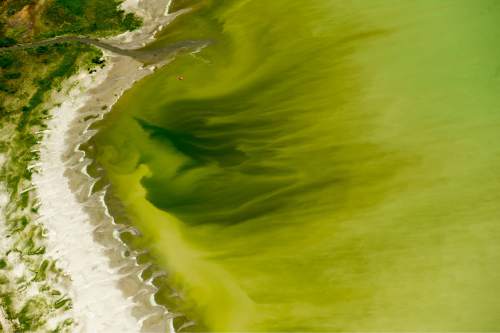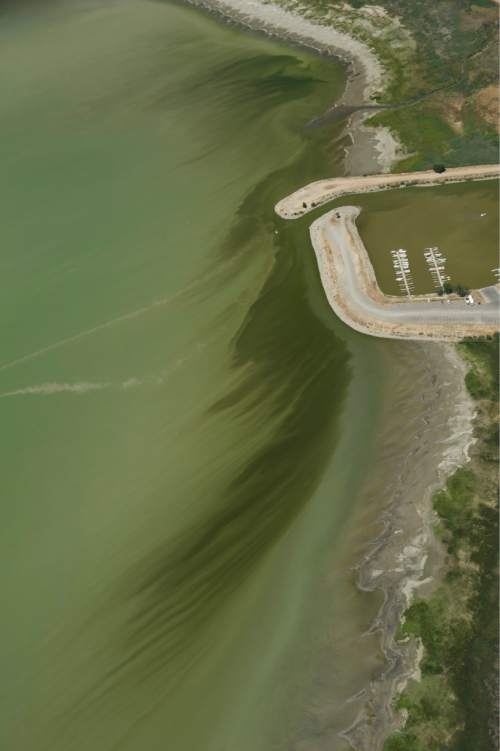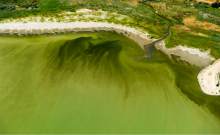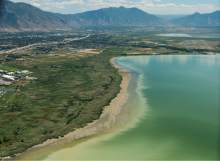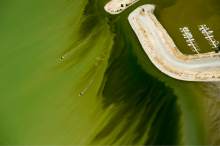This is an archived article that was published on sltrib.com in 2016, and information in the article may be outdated. It is provided only for personal research purposes and may not be reprinted.
Algal monitoring efforts continue to move northward as state environmental officials strive to get a handle on what the largest algal bloom in Utah Lake's history means for Utah water quality.
This is the first known instance in which a bloom originating in Utah Lake has affected the Jordan River and other downstream systems. And concentrations within the bloom are exceptionally high, with some samples surpassing tens of millions of cyanobacteria — the so-called toxin-producing algae — per milliliter. According to the state Department of Environmental Quality, cyanobacteria numbering in excess of 1 million cells per milliliter are present as far north as Murray.
A 2014 Utah Lake bloom that is thought to have killed two dogs had cell counts in the hundreds of thousands.
Though cyanobacteria naturally are present in most water systems, two studies of the lake's history concur that the current condition of Utah Lake is not natural, said Erica Gaddis, assistant director of the Utah Division of Water Quality (DWQ).
Gaddis said she believed a combination of calm, hot weather; exceptionally low lake levels; and the ongoing discharge of pollutants into Utah Lake likely caused the recent growth. Generally regarded and classified as algae due to their behavior, cyanobacteria technically are species of bacteria that thrive in warm environments rich in nutrients like phosphorus and nitrogen.
The majority of that nutrient pollution comes from treated wastewater that is discharged from the surrounding communities into the lake, Gaddis said. The state has instituted a rule that would cut releases of phosphorus from these facilities by two-thirds, but compliance isn't mandatory until 2020.
The DWQ initiated in November a study of Utah Lake that aims to outline in specific terms exactly how much phosphorus and nitrogen the lake can absorb without negative environmental consequences.
"That study will identify where we really need to go … to protect and restore Utah Lake," Gaddis said.
This latest event has prompted the DWQ to work more closely with Utah County to control stormwater collection and runoff, and to create a new position for a staffer who will work to educate the Utah County community to further reduce the release of nutrients into the lake.
But there is little that can be done to control the bloom in the short term, Gaddis said. The DWQ is looking into whether chemical treatments used to clear small ponds of algae could be used on a body of water the size of Utah Lake, but there are concerns that doing so could cause the algae to release their own toxins, creating an even greater hazard.
Meanwhile, state officials have begun sampling the Jordan River and wetlands near the Great Salt Lake in Davis County. The Central Davis Sewer District, which is involved in an ongoing effort to study the Great Salt Lake, plans to collect samples from Farmington Bay on Wednesday and share that data with the Utah Department of Environmental Quality (DEQ), Gaddis said.
The Utah County Health Department has opted for a formal closure of the Jordan River through Utah County. The Salt Lake County Health Department opted for a less stringent health warning Monday. Salt Lake City has posted signs at public access points.
The pond in Salt Lake City's Liberty Park has been closed while it's flushed with water from an alternative source. The Jordan River Off-Highway Vehicle State Recreation Area, where water from the Jordan River is used for dust control, is closed. Similar concerns inspired Kennecott to redirect work on a large reclamation project outside the mine to other activities while the company reroutes an alternative water source to serve that site.
Though the DEQ has confirmed the presence of large numbers of cyanobacteria species capable of producing toxins, the state is waiting for test results that would confirm the presence of those toxins. The actual release of toxins is difficult to predict, Gaddis said. Sometimes the bacteria release toxins as their populations soar; other times, the toxins are released as the microorganisms die.
Toxins or no, Barbara Crouch, executive director of the Utah Poison Control Center, said exposure to the algae themselves can cause symptoms in some people. Contact with the algae is associated with rashes and skin and eye irritation similar to an allergic reaction. Exposure via ingestion is more concerning, especially for pets and other animals, because the dose of algae — and, possibly, their associated toxins — is much larger.
Exposure to the algae and their toxins also is possible, via inhalation of droplets sprayed into the air by, for example, a sprinkler system or a water vehicle, Crouch said.
The state Department of Agriculture and Food also advises against using potentially contaminated water for crops, and the DWQ has advised residents to avoid eating produce watered with secondary water sourced from Utah Lake or the Jordan River. Cyanobacteria toxins may accumulate in plant tissues, according to the DEQ.
Utah Poison Control continues to receive numerous calls reporting illnesses associated with exposure to the contaminated water. There is no diagnostic test that can determine for sure whether a person was exposed to algal toxins, Crouch said, so the center is collaborating with state and local health departments to evaluate each case and determine whether the reported health effects likely were related to algae.
The majority of reported cases involve gastrointestinal symptoms including nausea, vomiting and diarrhea — symptoms consistent with exposure to cyanobacteria liver toxins, Crouch said. But callers also have complained of headache, which could be associated with neurotoxins, and eye and skin irritation. In most cases, Crouch said, symptoms are limited and appear to improve on their own with time.
Persons who have been exposed to the contaminated water and who are experiencing symptoms are encouraged to call poison control at 800-222-1222. Those with concerns about exposed animals may also call the center, though they may be referred to a veterinarian for specialized care.
Twitter: @EmaPen



